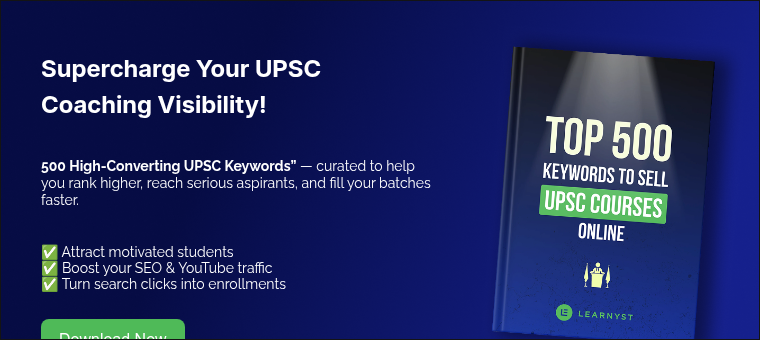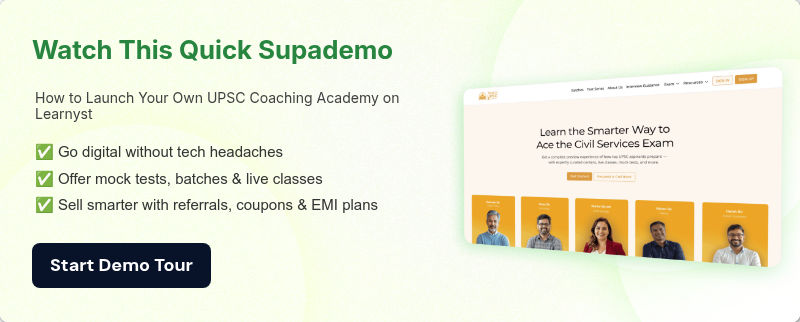Why an LMS Is Better Than YouTube for UPSC Coaching
- June 21 2025
- Akash Patil
One of the most prominent and competitive examinations in India is the Union Public Service Commission (UPSC) exam. Coaching has changed from traditional classroom settings to online platforms, with thousands of applicants trying for a few hundred positions annually. During this shift, YouTube has gained popularity as a platform for sharing instructional materials.
The catch is that video lectures alone are insufficient for effective UPSC coaching.
YouTube lacks the organization, focus, and resources an applicant needs to ace the UPSC exam, despite being accessible and free. A Learning Management System (LMS) can help with that. An LMS platform, such as Learnyst, is made especially to provide excellent learning experiences that are safe, customized, and in line with test-taking tactics.
Let’s explore in detail why an LMS is far superior to YouTube for UPSC coaching—both for students and educators.
According to Times of India news article IFS topper Kanika Anabh she preferred online study resources to prepare for her examination

Why an LMS Is Better Than YouTube
1. Content Structure and Syllabus Alignment
YouTube:
- Unstructured, repetitious, and dispersed content is common.
- Candidates find it difficult to adhere to a clear syllabus flow.
- Recommendations and irrelevant videos can easily divert your attention.
LMS:
- The UPSC syllabus (Prelims, Mains, Optional subjects) is incorporated into the design and alignment of the courses.
- The lessons are organized into logical modules, such as Polity → Constitution → Preamble → Fundamental Rights.
- Students adhere to a clearly defined course, guaranteeing that the entire syllabus is covered.
Outcome:
Enhanced Memorization Skills, focused education, and thorough coverage—no subject is overlooked.
2. Practice, Testing, and Answer Writing
Success on the UPSC requires more than just watching videos. It's about putting what you learn into practice.
YouTube:
- No built-in tool for creating answers or taking practice exams.
- Students are required to test themselves using pen and paper or third-party apps.
LMS (like Learnyst):
- Incorporated UPSC-style mock exams (MCQs for preliminary exams, subjective for main exams).
- Instant ranking, evaluation, solutions, and answer keys.
- Tests are conducted weekly and monthly to evaluate progress.
- Every test has comprehensive analytics and peer comparison.
Outcome:
Students test themselves frequently, pinpoint their areas of weakness, and advance more quickly.
3. Content Security and Access Control
Because of the dangers of piracy, educators frequently hesitate to share expensive content on YouTube.
YouTube:
- Free tools are available for downloading videos.
- Copyright problems and content theft are prevalent.
- Teachers are no longer in charge of who views and distributes their material.
LMS:
- Digital Rights Management, or DRM, is used by LMS to stop illegal sharing, screen capture, and downloads.
- Only enrolled students will have access to the course.
- Your hard work is protected by access restrictions and watermarking.
Outcome:
Teachers establish their own brand and safeguard their intellectual property.
4. Tracking Student Progress
YouTube:
- It's impossible to determine whether a student watched the entire video or comprehended the material.
- no information about the engagement or progress of the learners.
LMS:
- View which lessons were finished by which students.
- Keep track of test results, quiz attempts, drop-off points, and time spent.
- Determine which students are struggling and which are performing well.
Outcome:
Teachers provide individualized support and make data-driven decisions.
5. Interaction and Learning Community
For UPSC, community learning is essential, particularly for group discussions, answer writing, and resolving doubts.
YouTube:
- The comment sections are frequently noisy and lack moderation.
- No opportunity for direct teacher-student interaction or peer discussions.
LMS:
- Integrated community chat, discussion boards, and threads for answering questions.
- Live classes that include polls, hand-raising, and Q&A sessions.
- Group activities and peer-to-peer mentoring.
Outcome:
Throughout their preparation, learners experience greater engagement, support, and a decrease in isolation by using LMS.
6. Monetization and Revenue Control
YouTube:
- 4,000 watch hours and 1,000 subscribers are needed for revenue.
- Ad views (low CPM in India) determine revenue
- No straightforward method of marketing mentorship or courses.
LMS:
- Teachers can offer subscriptions, sell paid courses, or combine mentoring and coaching.
- Make several price tiers: Basic, Premium, and Free.
- Complete authority over revenue, discounts, and prices.
Outcome:
By leveraging a robust LMS, you cultivate a genuine, enduring business—one rooted in knowledge and growth rather than acting as a mere transactional conduit.
“Educators using Learnyst report up to 3X revenue growth compared to relying on YouTube alone.”
7. Communication and Learner Retention
It takes one to two years to prepare for the UPSC. It can be difficult to maintain students' consistency.
YouTube:
- No feature for scheduling messages, sending reminders, or publishing frequent updates.
LMS:
- Send push alerts for new courses, upcoming classes, or motivation through the Learnyfy App.
- Post announcements, PDF notes, and updates in the newsfeed.
- To keep students interested, use leaderboards, gamification, and streak systems.
Outcome:
Increased word-of-mouth recommendations, improved course completion rates, and increased student retention with LMS platform.
8. Recognition and Certification
YouTube:
- No formal completion record exists.
- No credentials or credibility enhancement for students
LMS:
- Certificates of course completion that are automatically generated.
- Increases the credibility and trustworthiness of your coaching brand.
- During interviews or internships, students use these certificates to demonstrate their commitment.
Outcome:
Your brand is seen as credible and professional, and students feel rewarded through LMS.
9. Revision, Continuity, and Note-Taking
YouTube:
- Progress cannot be saved.
- No highlighting or bookmarking options.
LMS:
- Students can take notes in-app, bookmark lessons, and pick up where they left off.
- Courses can be accessed offline through the app.
- Flashcards, downloadable materials, and PDFs facilitate quicker revision.
Outcome:
The LMS fosters improved memory retention, helping learners internalize knowledge more effectively and build long-term understanding.
.png?width=1920&height=1080&name=Green%20Corporate%20Minimalist%20Infographic%20Presentation%20(6).png)
Final Thoughts: LMS > YouTube for Serious UPSC Coaching
One excellent tool for generating leads is YouTube. It aids educators in becoming known and gaining followers. However, an LMS is the whole package when it comes to real learning, performance, and outcomes.
For serious UPSC aspirants, an LMS offers:
✅ Consistency
✅ Test readiness
✅ Personalization
✅ Motivation
✅ Privacy
✅ Results
For educators, an LMS offers:
✅ Course sales
✅ Secure hosting
✅ Student analytics
✅ Community building
✅ Brand ownership
✅ Better income
Ready to Launch Your Own UPSC Coaching Academy?
You can start your own branded UPSC coaching platform with Learnyst in a matter of days rather than months. No tech headaches, no coding.
- Launch your own app (Learnyfy/Courseguard) and website.
- Provide safe UPSC training and practice exams.
- Increase your income while taking full ownership.
- Create a brand for your online coaching business.
FAQs
1. Is YouTube sufficient for UPSC preparation?
Although YouTube provides free resources, it does not offer individualized study plans, structured guidance, or doubt resolution. For serious candidates, a Learning Management System (LMS) such as Unacademy or Drishti IAS is a better option because it offers carefully chosen courses, professional mentoring, and methodical preparation.
2. Why LMS is better than YouTube teaching?
In contrast to YouTube's disorganized content, a learning management system (LMS) provides interactive learning, expert guidance, and structured courses. LMS platforms are perfect for serious learners because they offer mentorship, progress tracking, and carefully thought-out study plans.
3. How can I start my own UPSC coaching center?
Focus on scalable online learning, knowledgeable faculty, and organized content when starting a UPSC coaching center. With live classes, practice exams, and student engagement resources, a learning management system (LMS) such as Learnyst assists you in developing, promoting, and selling UPSC courses. It simplifies processes, increasing the effectiveness and accessibility of online coaching.
.png)



Leave your thought here